In today’s competitive digital landscape, European businesses face a critical decision when outsourcing IT: should they choose nearshore or offshore development partners? While both models offer cost advantages over in-house teams, the differences between them can significantly impact your project’s success, team dynamics, and long-term business outcomes.
As an European-based IT service provider, we have seen firsthand how nearshore software development delivers superior results for companies across the continent. Let us explore why proximity, cultural alignment, and collaboration quality make nearshore the smarter choice for European businesses.
Understanding the models: Nearshore vs Offshore
Before diving into the comparison, it’s essential to understand what these terms mean.
Nearshore software development
Nearshore refers to outsourcing IT services to companies in nearby countries, typically within the same or adjacent time zones. For European businesses, this means partnering with development teams in countries like Portugal, Spain, Poland, Romania, or other European nations.
Offshore outsourcing
Offshore involves working with teams in distant countries with significant time zone differences, commonly in Asia (India, Philippines, Vietnam) or distant parts of Latin America.
Both models aim to reduce costs and access specialized talent, but the execution and outcomes differ dramatically.
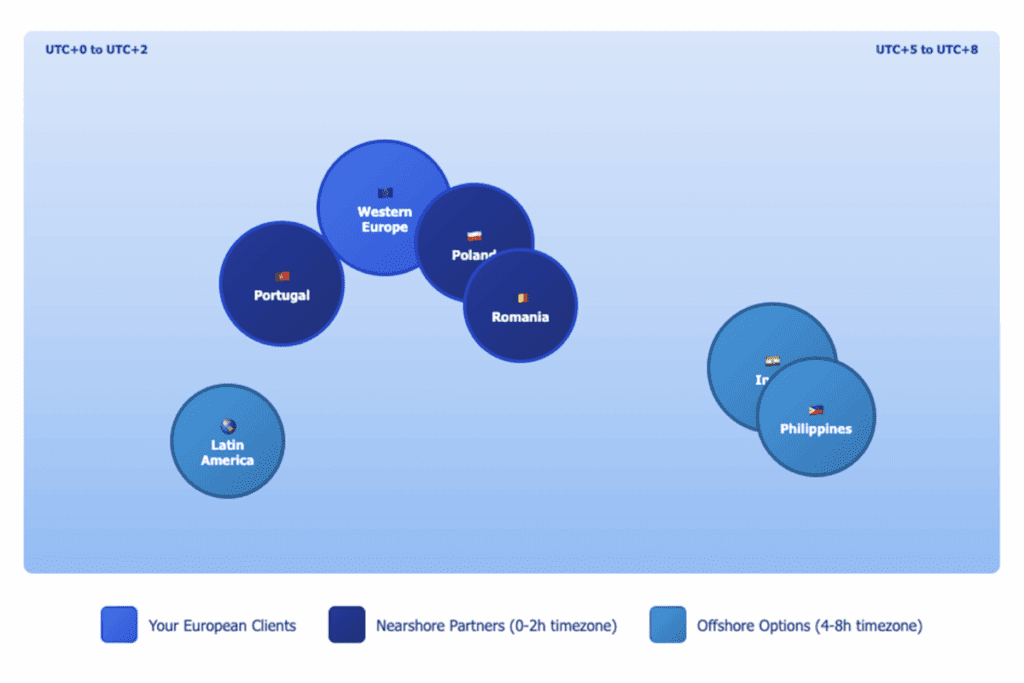
The time zone advantage: Real-time collaboration
One of the most compelling arguments for nearshore software development is the time zone alignment. When your development team operates within 1-3 hours of your business hours, collaboration becomes seamless and natural.
Nearshore benefits
- Daily standup meetings at convenient times for everyone
- Immediate responses to urgent issues during your working hours
- Overlapping work hours enable real-time problem-solving
- Sprint planning and retrospectives that fit naturally into everyone’s schedule
Offshore challanges
- 6-12 hour time differences create communication delays
- Questions raised at 10 AM might not get answered until the next day
- Emergency fixes require someone to work outside normal hours
- Asynchronous communication slows down decision-making
Consider a real scenario: Your team discovers a critical bug before product launch. With nearshore software development, you can jump on a call within minutes and deploy the fix the same day. With offshore outsourcing, you’re waiting until evening or the next morning to even begin discussions.
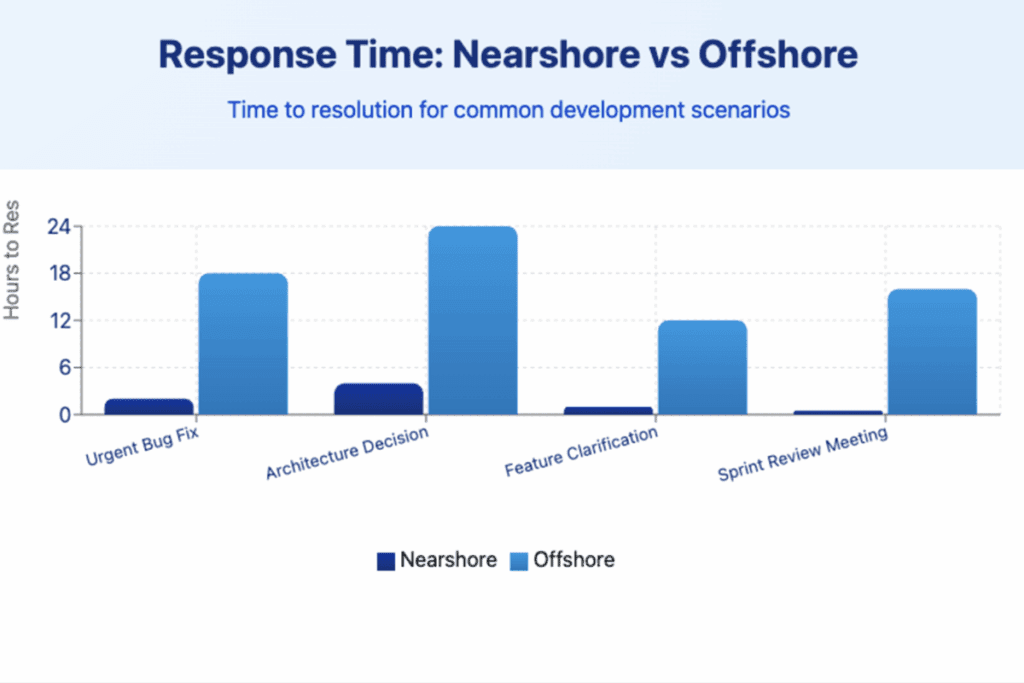
Cultural Compatibility and Team Integration
When outsourcing IT services, technical skills are just the starting point. Cultural alignment and communication quality determine whether your extended team feels like true partners or distant contractors.
European nearshore providers share fundamental business values with their clients: similar work ethics, comparable educational systems, understanding of European business culture and compliance requirements, and direct communication styles. These cultural synergies translate into tangible benefits—your nearshore team understands European holidays, business rhythms, and customer expectations without extensive onboarding.
Language proficiency also plays a crucial role. Most nearshore European developers speak excellent English, and many offer services in German, French, or Spanish. This multilingual capability ensures clear communication and reduces costly misunderstandings.
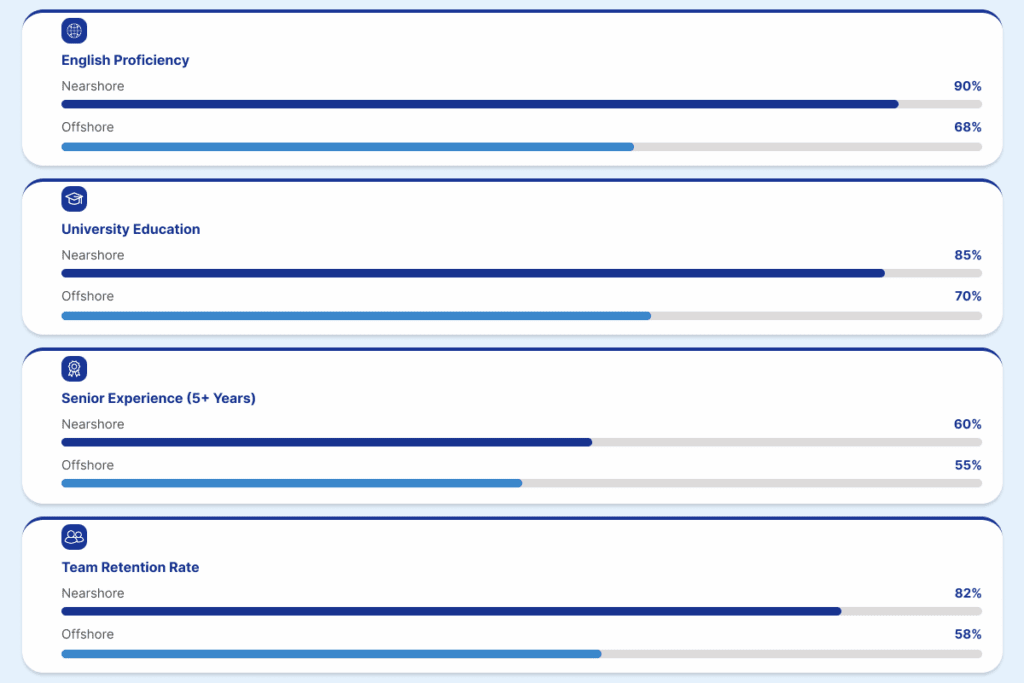
Team extension: The integrated approach
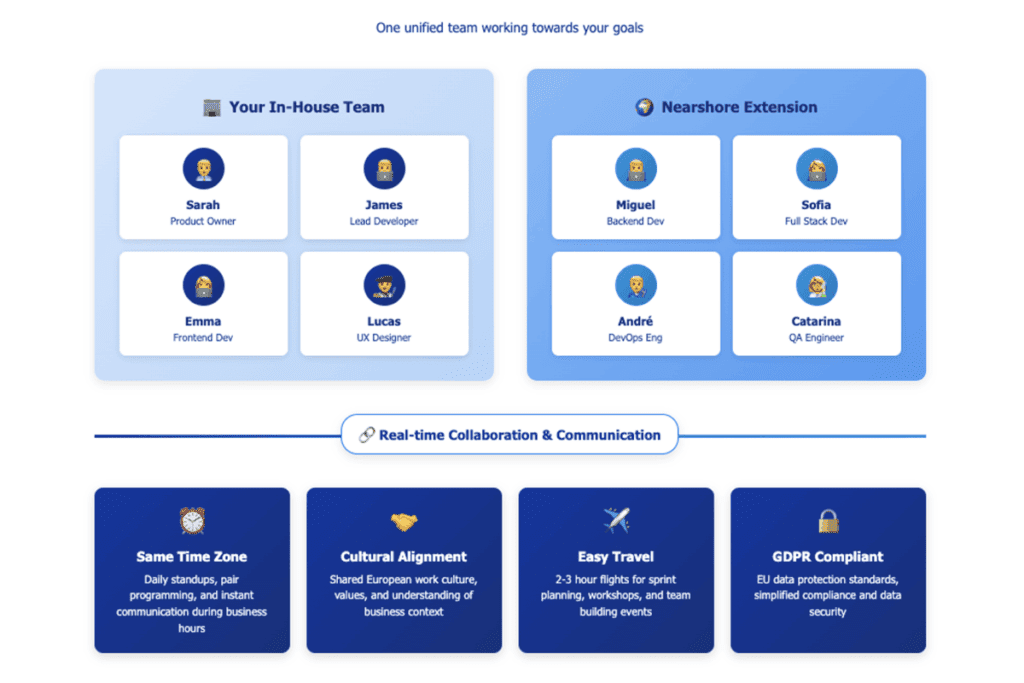
Team extension has become the preferred model for many European companies, and nearshore partnerships excel in this approach. Rather than outsourcing entire projects to a black box, team extension integrates external developers into your existing teams as seamless extensions of your workforce.
Nearshore team extension advantages:
- Smooth integration: Nearshore developers can visit your offices easily for kickoff meetings, quarterly reviews, or critical project phases. A flight from Lisbon to London, Berlin, or Paris takes just 2-3 hours, enabling face-to-face collaboration when needed.
- Cultural fit and adaptation: Because nearshore teams share similar work cultures, they adapt quickly to your company’s processes, tools, and communication styles. They understand Agile methodologies, DevOps practices, and modern software development workflows that are standard across Europe.
- Flexibility and scalability: Need to scale up for a major release? Nearshore partners can quickly add skilled developers who integrate smoothly with your existing team. When the project phase ends, you can scale down without the complexities of local employment contracts.
- Knowledge retention and stability: The stability of nearshore relationships means lower turnover. Your extended team members stay with projects longer, building institutional knowledge and becoming true experts in your product and business domain.
Offshore team extension faces more obstacles. The time zone gap makes daily integration difficult, and the cultural distance can create an “us versus them” dynamic rather than a unified team feeling.
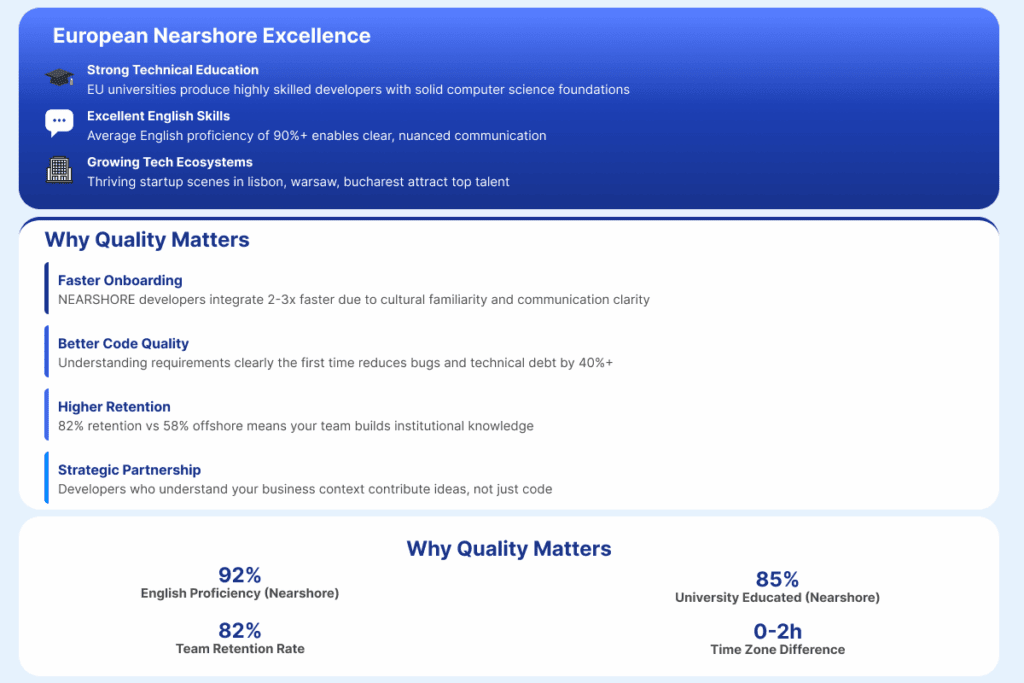
Cost efficiency: Beyond the hourly rate
Yes, offshore rates are typically lower on paper. An offshore developer might cost €15-30 per hour compared to €30-50 for nearshore. However, focusing solely on hourly rates ignores the total cost of ownership.
Hidden costs of offshore outsourcing
- Communication overhead requiring more documentation, recorded meetings, and requirement clarifications
- Quality issues from cultural and process gaps, leading to bugs, rework, and technical debt
- Project delays from time zone challenges and communication inefficiencies
- Travel expenses for necessary face-to-face meetings (Asia flights significantly exceed European travel costs)
- Management burden requiring more oversight and coordination from internal staff
Nearshore software development delivers better value
- Higher productivity: Real-time collaboration enables faster development cycles
- Better quality: Cultural alignment and direct communication reduce misunderstandings and defects
- Lower management overhead: Your team spends less time coordinating and more time building
- Faster time-to-market: Efficient workflows and minimal delays mean quicker releases
When you calculate the true ROI, including time saved, quality improvements, and reduced management burden, nearshore often proves more cost-effective despite higher nominal rates.
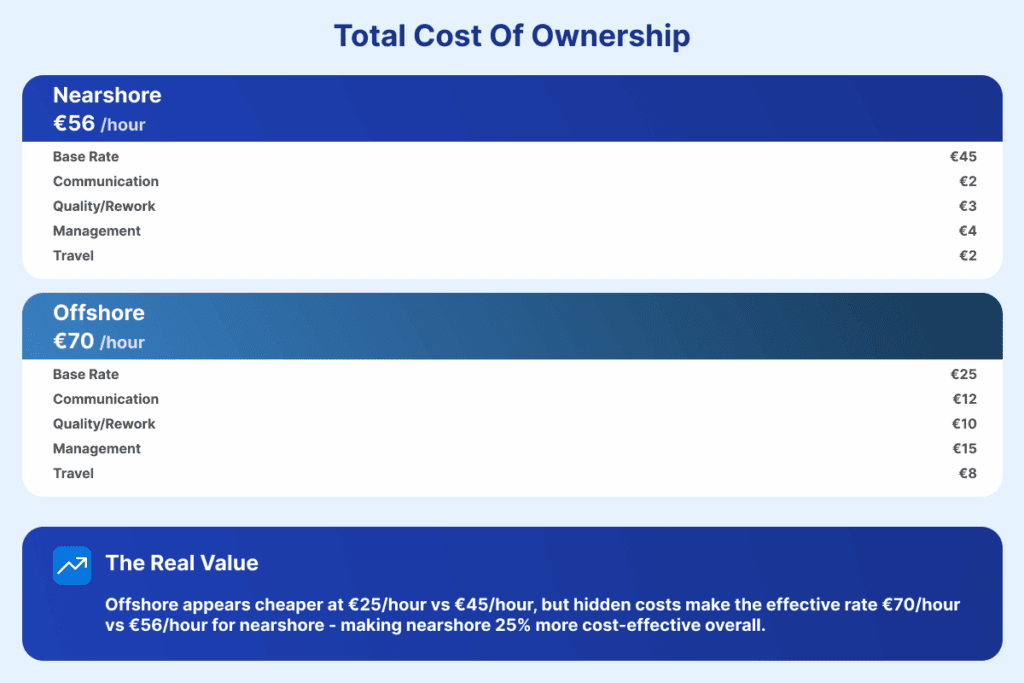
Strategic Partnership: Beyond transactional relationships
Nearshore relationships tend to evolve into genuine strategic partnerships rather than transactional vendor relationships. The ease of travel enables regular in-person sprint reviews, shared workshops for knowledge transfer, and team building activities that strengthen relationships.
These deeper connections create invested partners who understand your business goals, not just technical requirements. Your nearshore team becomes an extension of your company culture, advocating for your success and proactively suggesting improvements—something rarely achieved with offshore outsourcing IT models.
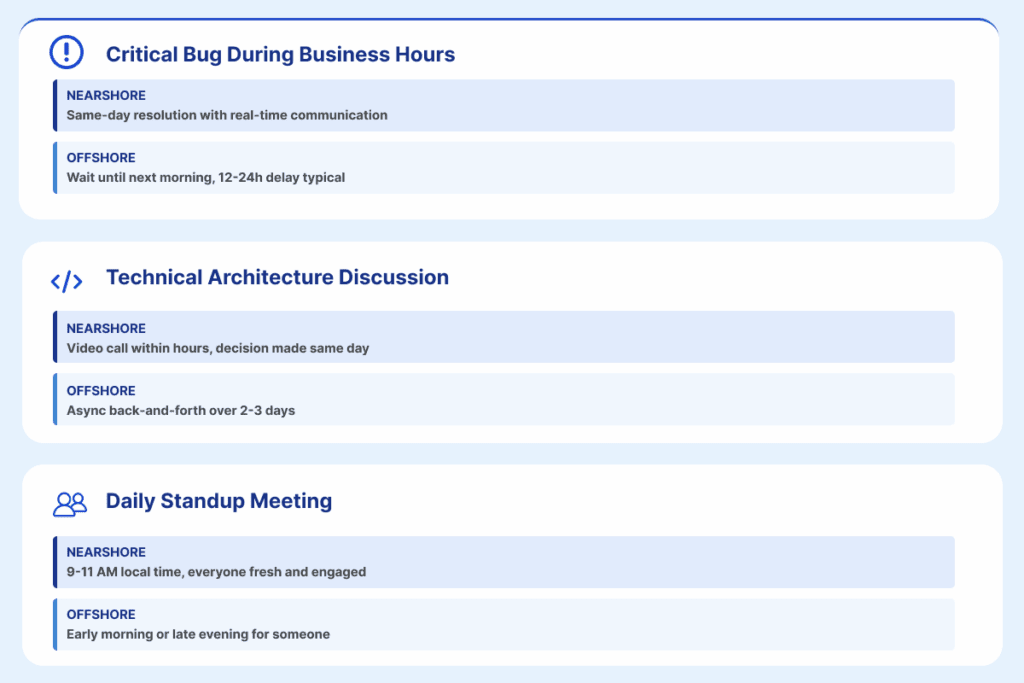
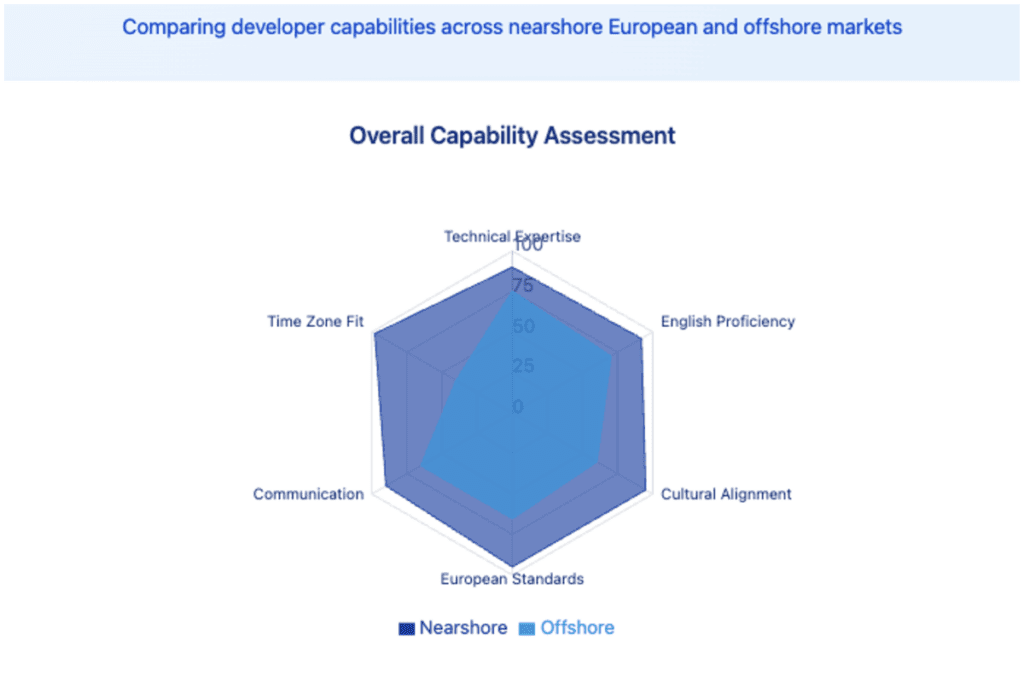

In an increasingly connected world, it might seem geography shouldn’t matter for software development. In practice, proximity—in time zones, culture, and physical distance—creates substantial advantages that directly impact project success.
Nearshore software development offers European companies the optimal balance: significant cost savings compared to local hiring, coupled with the collaboration quality, cultural alignment, and strategic partnership benefits that offshore alternatives cannot match.
When choosing your outsourcing IT partner, look beyond the hourly rate to the total value delivered. For European businesses serious about digital transformation and building high-performing distributed teams, nearshore is not just an alternative to offshore—it’s the superior choice.
Legal, compliance and data protection
For European companies, particularly those handling sensitive customer data, legal and regulatory considerations are paramount. Nearshore software development within Europe provides significant advantages in this area.
GDPR compliance: Nearshore European partners operate under the same GDPR framework as your business, simplifying data protection compliance. Offshore providers in Asia or Latin America require complex data transfer agreements and create additional compliance risks.
Intellectual property protection: European legal frameworks provide stronger, more consistent IP protection. Contract enforcement and dispute resolution are more straightforward within European jurisdictions.
Regulatory alignment: Whether you’re in fintech, healthtech, or other regulated industries, nearshore European partners understand EU regulations and can help ensure compliance rather than creating additional compliance challenges.
Data sovereignty: For many sectors, keeping data within European borders isn’t just preferable—it’s mandatory. Nearshore partnerships make this seamless.
Proximity matters in software development
Let’s talk about how Nearshore Portugal can help you achieve your goals.

CEO @Nearshore Portugal
